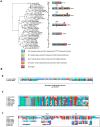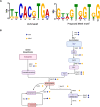Modulation of the complex regulatory network for methionine biosynthesis in fungi
- PMID: 33724418
- PMCID: PMC8045735
- DOI: 10.1093/genetics/iyaa049
Modulation of the complex regulatory network for methionine biosynthesis in fungi
Abstract
The assimilation of inorganic sulfate and the synthesis of the sulfur-containing amino acids methionine and cysteine is mediated by a multibranched biosynthetic pathway. We have investigated this circuitry in the fungal pathogen Candida albicans, which is phylogenetically intermediate between the filamentous fungi and Saccharomyces cerevisiae. In S. cerevisiae, this pathway is regulated by a collection of five transcription factors (Met4, Cbf1, Met28, and Met31/Met32), while in the filamentous fungi the pathway is controlled by a single Met4-like factor. We found that in C. albicans, the Met4 ortholog is also a core regulator of methionine biosynthesis, where it functions together with Cbf1. While C. albicans encodes this Met4 protein, a Met4 paralog designated Met28 (Orf19.7046), and a Met31 protein, deletion, and activation constructs suggest that of these proteins only Met4 is actually involved in the regulation of methionine biosynthesis. Both Met28 and Met31 are linked to other functions; Met28 appears essential, and Met32 appears implicated in the regulation of genes of central metabolism. Therefore, while S. cerevisiae and C. albicans share Cbf1 and Met4 as central elements of the methionine biosynthesis control, the other proteins that make up the circuit in S. cerevisiae are not members of the C. albicans control network, and so the S. cerevisiae circuit likely represents a recently evolved arrangement.
Keywords: genetics; methionine biosynthesis; regulatory complexes; rewiring; transcription factor.
© The Author(s) 2021. Published by Oxford University Press on behalf of Genetics Society of America. All rights reserved. For permissions, please email: journals.permissions@oup.com.
Figures





Similar articles
-
A dominant suppressor mutation of the met30 cell cycle defect suggests regulation of the Saccharomyces cerevisiae Met4-Cbf1 transcription complex by Met32.J Biol Chem. 2008 Apr 25;283(17):11615-24. doi: 10.1074/jbc.M708230200. Epub 2008 Feb 28. J Biol Chem. 2008. PMID: 18308733 Free PMC article.
-
Alternative sulphur metabolism in the fungal pathogen Candida parapsilosis.Nat Commun. 2024 Oct 24;15(1):9190. doi: 10.1038/s41467-024-53442-8. Nat Commun. 2024. PMID: 39448588 Free PMC article.
-
Characterizing the roles of Met31 and Met32 in coordinating Met4-activated transcription in the absence of Met30.Mol Biol Cell. 2012 May;23(10):1928-42. doi: 10.1091/mbc.E11-06-0532. Epub 2012 Mar 21. Mol Biol Cell. 2012. PMID: 22438580 Free PMC article.
-
Metabolism of sulfur amino acids in Saccharomyces cerevisiae.Microbiol Mol Biol Rev. 1997 Dec;61(4):503-32. doi: 10.1128/mmbr.61.4.503-532.1997. Microbiol Mol Biol Rev. 1997. PMID: 9409150 Free PMC article. Review.
-
Generating anchors only to lose them: The unusual story of glycosylphosphatidylinositol anchor biosynthesis and remodeling in yeast and fungi.IUBMB Life. 2018 May;70(5):355-383. doi: 10.1002/iub.1734. IUBMB Life. 2018. PMID: 29679465 Review.
Cited by
-
Cell envelope and stress-responsive pathways underlie an evolved oleaginous Rhodotorula toruloides strain multi-stress tolerance.Biotechnol Biofuels Bioprod. 2024 May 28;17(1):71. doi: 10.1186/s13068-024-02518-0. Biotechnol Biofuels Bioprod. 2024. PMID: 38807231 Free PMC article.
-
Molecular Determinants Involved in Candida albicans Biofilm Formation and Regulation.Mol Biotechnol. 2024 Jul;66(7):1640-1659. doi: 10.1007/s12033-023-00796-x. Epub 2023 Jul 6. Mol Biotechnol. 2024. PMID: 37410258 Review.
-
Surviving in the Brine: A Multi-Omics Approach for Understanding the Physiology of the Halophile Fungus Aspergillus sydowii at Saturated NaCl Concentration.Front Microbiol. 2022 May 2;13:840408. doi: 10.3389/fmicb.2022.840408. eCollection 2022. Front Microbiol. 2022. PMID: 35586858 Free PMC article.
-
Methionine biosynthesis enzyme MoMet2 is required for rice blast fungus pathogenicity by promoting virulence gene expression via reducing 5mC modification.PLoS Genet. 2023 Sep 21;19(9):e1010927. doi: 10.1371/journal.pgen.1010927. eCollection 2023 Sep. PLoS Genet. 2023. PMID: 37733784 Free PMC article.
-
Exploring the stress response mechanisms to 2-phenylethanol conferred by Pdr1p mutation in Saccharomyces cerevisiae.Biotechnol Biofuels Bioprod. 2024 Aug 1;17(1):109. doi: 10.1186/s13068-024-02559-5. Biotechnol Biofuels Bioprod. 2024. PMID: 39090744 Free PMC article.
References
-
- Baker RE, Fitzgerald-Hayes M, O'Brien TC. 1989. Purification of the yeast centromere binding protein CP1 and a mutational analysis of its binding site. J Biol Chem. 264:10843–10850. - PubMed
Publication types
MeSH terms
Substances
LinkOut - more resources
Full Text Sources
Other Literature Sources

